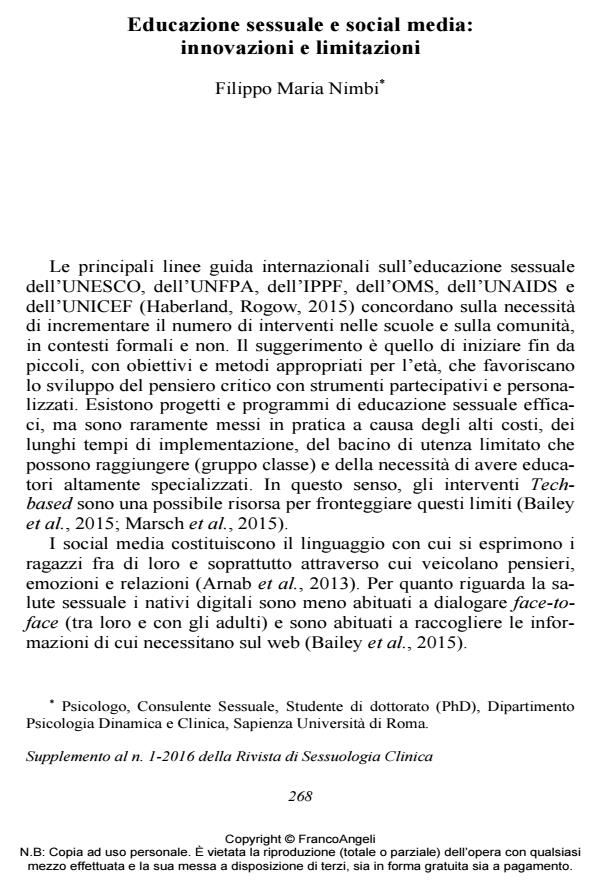Educazione sessuale e social media: innovazioni e limitazioni
Titolo Rivista RIVISTA DI SESSUOLOGIA CLINICA
Autori/Curatori Filippo Maria Nimbi
Anno di pubblicazione 2016 Fascicolo 2016/suppl. 1 Lingua Italiano
Numero pagine 3 P. 268-270 Dimensione file 132 KB
DOI 10.3280/RSC2016-SU1070
Il DOI è il codice a barre della proprietà intellettuale: per saperne di più
clicca qui
Qui sotto puoi vedere in anteprima la prima pagina di questo articolo.
Se questo articolo ti interessa, lo puoi acquistare (e scaricare in formato pdf) seguendo le facili indicazioni per acquistare il download credit. Acquista Download Credits per scaricare questo Articolo in formato PDF

FrancoAngeli è membro della Publishers International Linking Association, Inc (PILA)associazione indipendente e non profit per facilitare (attraverso i servizi tecnologici implementati da CrossRef.org) l’accesso degli studiosi ai contenuti digitali nelle pubblicazioni professionali e scientifiche
- Arnab S., Brownb K., Clarke S., Dunwell I., Lim T., Suttiec N., Louchartc S., Hendrixa M., de Freitasa S. (2013). The development approach of a pedagogically-driven serious game to support Relationship and Sex Education (RSE) within a classroom setting. Computers & Education, 69: 15-30.
- Bailey J., Mann S., Wayal S., Hunter R., Free C., Abraham C., Murray E. (2015). Sexual health promotion for young people delivered via digital media: a scoping review. Public Health, 3(13).
- Domingo M.G., Gargante A.B. (2015). Exploring the use of educational technology in primary education: Teachers’ perception of mobile technology learning impacts and applications’ use in the classroom. Computers in Human Behavior, 56: 21-28.
- Haberland N., Rogow D. (2015). Sexuality Education: Emerging Trends in Evidence and Practice. Journal of adolescent health, 56: S15-S21.
- Krishnan A., Ferro E.G., Weikum D., Vagenas P., Lama J.R., Sanchez J., Altice F.L. (2014). Communication technology use and mHealth acceptance among HIV-infected men who have sex with men in Peru: implications for HIV prevention and treatment. AIDS Care, 27 (3): 273-282. DOI: 10.1080/09540121.2014.963014
- Marsch L.A., Guarino H., Grabinski M.J., Syckes C., Dillingham E.T., Xie H., Crosier B.S. (2015). Comparative Effectiveness of Web-Based vs. Educator-Delivered HIV Prevention for Adolescent Substance Users: A Randomized, Controlled Trial. Journal of Substance Abuse Treatment, 59: 30-37.
- Young S.D., Cumberland W.G., Lee S.J., Jaganath D., Szekeres G., Coates T. (2013). Social Networking Technologies as an Emerging Tool for HIV Prevention. Ann Intern Med, 159: 318-324. DOI: 10.7326/0003-4819-159-5-201309030-00005
Filippo Maria Nimbi, Educazione sessuale e social media: innovazioni e limitazioni in "RIVISTA DI SESSUOLOGIA CLINICA" suppl. 1/2016, pp 268-270, DOI: 10.3280/RSC2016-SU1070